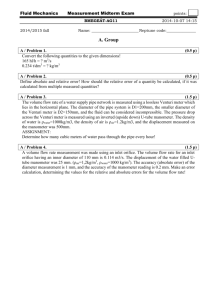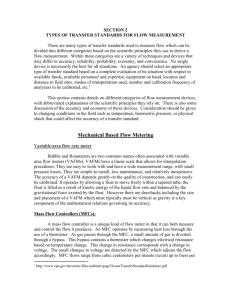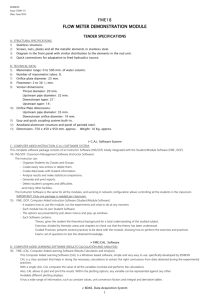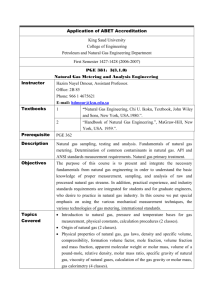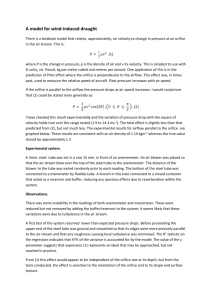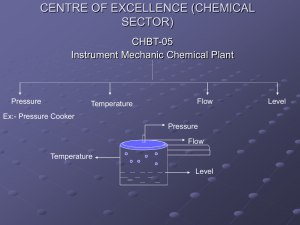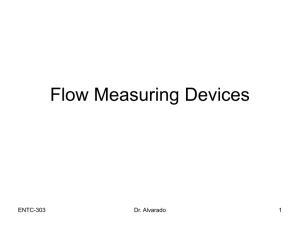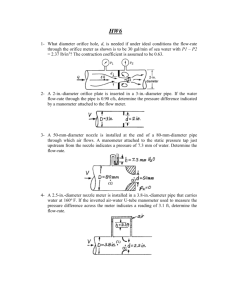Lecture 13 Flow Measurement in Pipes
advertisement
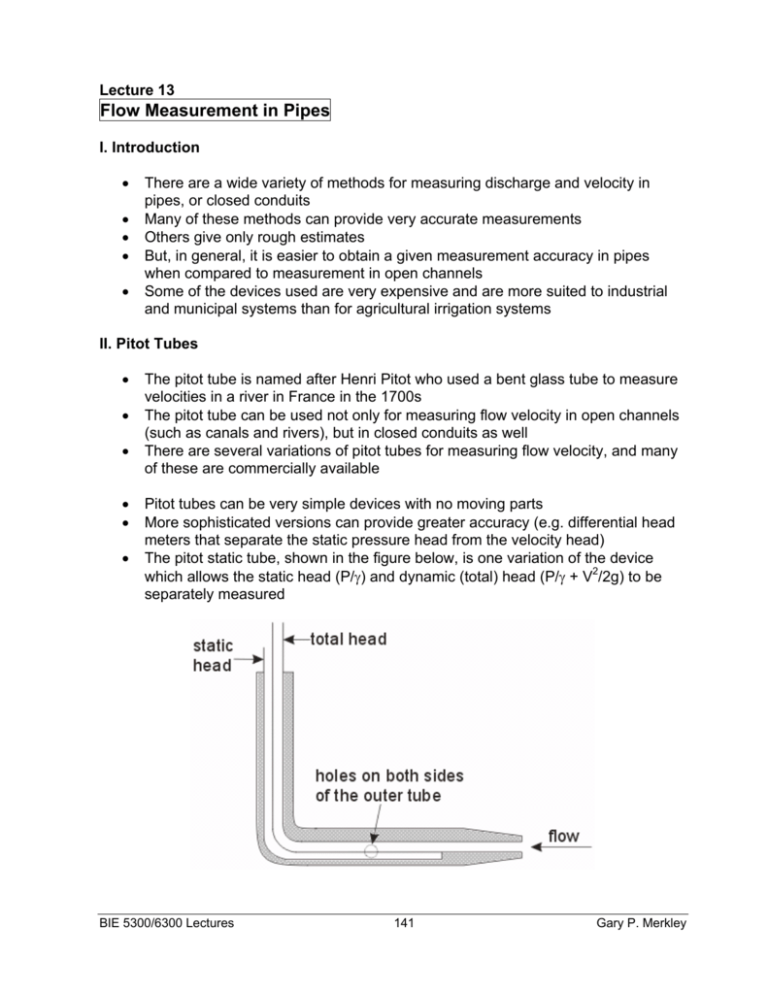
Lecture 13 Flow Measurement in Pipes I. Introduction • • • • • There are a wide variety of methods for measuring discharge and velocity in pipes, or closed conduits Many of these methods can provide very accurate measurements Others give only rough estimates But, in general, it is easier to obtain a given measurement accuracy in pipes when compared to measurement in open channels Some of the devices used are very expensive and are more suited to industrial and municipal systems than for agricultural irrigation systems II. Pitot Tubes • • • • • • The pitot tube is named after Henri Pitot who used a bent glass tube to measure velocities in a river in France in the 1700s The pitot tube can be used not only for measuring flow velocity in open channels (such as canals and rivers), but in closed conduits as well There are several variations of pitot tubes for measuring flow velocity, and many of these are commercially available Pitot tubes can be very simple devices with no moving parts More sophisticated versions can provide greater accuracy (e.g. differential head meters that separate the static pressure head from the velocity head) The pitot static tube, shown in the figure below, is one variation of the device which allows the static head (P/γ) and dynamic (total) head (P/γ + V2/2g) to be separately measured BIE 5300/6300 Lectures 141 Gary P. Merkley • • The static head equals the depth if open-channel flow Calibrations are required because the velocity profile can change with the flow rate, and because measurement(s) are only a sampling of the velocities in the pipe • The measurement from a pitot tube can be accurate to ±1% of the true velocity, even if the submerged end of the tube is up to ±15% out of alignment from the flow direction The velocity reading from a pitot tube must be multiplied by cross-sectional area to obtain the flow rate (it is a velocity-area method) Pitot tubes tend to become clogged unless the water in the pipe is very clean Also, pitot tubes may be impractical if there is a large head, unless a manometer is used with a dense liquid like mercury • • • III. Differential Producers • • • This is a class of flow measurement devices for full pipe flow “Differential producers” cause a pressure differential which can be measured and correlated to velocity and or flow rate in the pipe Examples of differential producers: • • • • Venturis Nozzles Orifices Measured ∆P at a differential producer depends on: • • • Flow rate Fluid properties Element geometry IV. Venturi Meters • • The principle of this flow measurement device was first documented by J.B. Venturi in 1797 in Italy Venturi meters have only a small head loss, no moving parts, and do not clog easily Gary P. Merkley 142 BIE 5300/6300 Lectures • • • The principle under which these devices operate is that some pressure head is converted to velocity head when the crosssectional area of flow decreases (Bernoulli equation) Thus, the head differential can be measured between the upstream section and the throat section to give an estimation of flow velocity, and this can be multiplied by flow area to arrive at a discharge value The converging section is usually about 21º, and the diverging section is usually from 5 to 7º Head loss ∆h 21º D1 • 5º - 7º D2 Flow D1 A form of the calibration equation is: Q = C A2 2g ∆h(sg − 1) 1− β 4 (1) where C is a dimensionless coefficient from approximately 0.935 (small throat velocity and diameter) to 0.988 (large throat velocity and diameter); β is the ratio of D2/D1; D1 and D2 are the inside diameters at the upstream and throat sections, respectively; A2 is the area of the throat section; ∆h is the head differential; and “sg” is the specific gravity of the manometer liquid • • • The discharge coefficient, C, is a constant value for given venturi dimensions Note that if D2 = D1, then β = 1, and Q is undefined; if D0 > D1, you get the square root of a negative number (but neither condition applies to a venturi) The coefficient, C, must be adjusted to accommodate variations in water temperature BIE 5300/6300 Lectures 143 Gary P. Merkley • • • • • • • • • • The value of β is usually between 0.25 and 0.50, but may be as high as 0.75 Venturi meters have been made out of steel, iron, concrete, wood, plastic, brass, bronze, and other materials Most modern venturi meters of small size are made from plastic (doesn’t corrode) Many commercial venturi meters have patented features The upstream converging section usually has an angle of about 21° from the pipe axis, and the diverging section usually has an angle of 5° to 7° (1:6 divergence, as for the DS ramp of a BCW, is about 9.5°) Straightening vanes may be required upstream of the venturi to prevent swirling flow, which can significantly affect the calibration It is generally recommended that there should be a distance of at least 10D1 of straight pipe upstream of the venturi The head loss across a venturi meter is usually between 10 and 20% of ∆h This percentage decreases for larger venturis and as the flow rate increases Venturi discharge measurement error is often within ±0.5% to ±1% of the true flow rate value V. Flow Nozzles • • Flow nozzles operate on the same principle as venturi meters, but the head loss tends to be much greater due to the absence of a downstream diverging section There is an upstream converging section, like a venturi, but there is no downstream diverging section to reduce energy loss Gary P. Merkley 144 BIE 5300/6300 Lectures • • • • • Flow nozzles can be less expensive than venturi meters, and can provide comparable accuracy The same equation as for venturi meters is used for flow nozzles The head differential across the nozzle can be measured using a manometer or some kind of differential pressure gauge The upstream tap should be within ½D1 to D1 upstream of the entrance to the nozzle The downstream tap should be approximately at the outlet of the nozzle (see the figure below) HGL Flow Head loss D1 D2 A Flow Nozzle in a Pipe • The space between the nozzle and the pipe walls can be filled in to reduce the head loss through the nozzle, as seen in the following figure HGL Flow Head loss D1 D2 A “Solid” Flow Nozzle in a Pipe BIE 5300/6300 Lectures 145 Gary P. Merkley VI. Orifice Meters • • These devices use a thin plate with an orifice, smaller than the pipe ID, to create a pressure differential The orifice opening is usually circular, but can be other shapes: • • • • • • • • • • • • • • • Square Oval Triangular Others The pressure differential can be measured, as in venturi and nozzle meters, and the same equation as for venturi meters can be used However, the discharge coefficient is different for orifice meters It is easy to make and install an orifice meter in a pipeline – easier than a nozzle Orifice meters can give accurate measurements of Q, and they are simple and inexpensive to build But, orifice meters cause a higher head loss than either the venturi or flow nozzle meters As with venturi meters and flow nozzles, orifice meters can provide values within ±1% (or better) of the true discharge As with venturi meters, there should be a straight section of pipe no less than 10 diameters upstream Some engineers have used eccentric orifices to allow passage of sediments – the orifice is located at the bottom of a horizontal pipe, not in the center of the pipe cross section The orifice opening can be “sharp” (beveled) for better accuracy But don’t use a beveled orifice opening if you are going to use it to measure flow in both directions These are the beveling dimensions: upstream downstream ½D1 30 to 45 deg 0.005D1 to 0.02D1 ½D2 CL Gary P. Merkley 146 BIE 5300/6300 Lectures • • • • The upstream head is usually measured one pipe diameter upstream of the thin plate, and the downstream head is measured at a variable distance from the plate Standard calibrations are available, providing C values from which the discharge can be calculated for a given ∆h value In the following, the coefficient for an orifice plate is called “K”, not “C” The coefficient values depend on the ratio of the diameters and on the Reynold’s number of approach; they can be presented in tabular or graphical formats Head loss ∆h Flow vena contracta D1 D2 D1 0.5D1 An Orifice Meter in a Pipe • • • In the figure below, the Reynold’s number of approach is calculated for the pipe section upstream of the orifice plate (diameter D1, and the mean velocity in D1) Note also that pipe flow is seldom laminar, so the curved parts of the figure are not of great interest An equation for use with the curves for K: ⎡⎛ P ⎞ ⎛P ⎞⎤ Q = KA 2 2g ⎢⎜ u + zu ⎟ − ⎜ d + zd ⎟ ⎥ ⎠ ⎝ γ ⎠⎦ ⎣⎝ γ • • • • • (2) The above equation is the same form as for canal gates operating as orifices The ratio β is embedded in the K term Note that zu equals zd for a horizontal pipe (they are measured relative to an arbitrary elevation datum) Note that Pu/γ is the same as hu (same for Pd/γ and hd) Also, you can let ∆h = hu - hd BIE 5300/6300 Lectures 147 Gary P. Merkley • • Pd is often measured at a distance of about ½D1 downstream of the orifice plate, but the measurement is not too sensitive to the location, within a certain range (say ¼ D1 to D1 downstream) The following graph shows the K value for an orifice meter as a function of the ratio of diameters when the Reynold’s number of approach is high enough that the K value no longer depends on Re Orifice Meter Coefficient for High Reynold's Number 0.70 0.69 0.68 0.67 K 0.66 0.65 0.64 0.63 0.62 0.61 0.60 0.30 0.35 0.40 0.45 0.50 0.55 0.60 0.65 0.70 D2/D1 Gary P. Merkley 148 BIE 5300/6300 Lectures Orifice Plate Calibrations • • A perhaps better way to calibrate sharp-edged orifice plates in pipes is based on the following equations Flow rate can be calculated through the orifice using the following equation: Q = Cd A 2 2g∆h(sg − 1) 1− β (3) 4 where Cd is a dimensionless orifice discharge coefficient, as defined below; A2 is the cross-sectional area of the orifice plate opening; g is the ratio of weight to mass; ∆h is the change in piezometric head across the orifice; and, β is a dimensionless ratio of the orifice and pipe diameters: β= D2 D1 (4) where D2 is the diameter of the circular orifice opening; and, D1 is the inside diameter of the upstream pipe • • • • • • • • In Eq. 3, “sg” is the specific gravity of the manometer fluid, and the constant “1” represents the specific gravity of pure water The specific gravity of the manometer liquid must be greater than 1.0 Thus, if a manometer is used to measure the head differential across the orifice plate, the term “∆h(sg - 1)” represents the head in depth (e.g. m or ft) of water If both ends of the manometer were open to the atmosphere, and there’s no water in the manometer, then you will see ∆h = 0 But if both ends of the manometer are open to the atmosphere, and you pour some water in one end, you’ll see ∆h > 0, thus the need for the “(sg – 1)” term Note that the specific gravity of water can be slightly different than 1.000 when the water is not pure, or when the water temperature is not exactly 5°C See the figure below Note also that the manometer liquid must not be water soluble! BIE 5300/6300 Lectures 149 Gary P. Merkley flow Head of water = ∆h(sg - 1) sg = 1 ∆h sg > 1 • The inside pipe diameter, D1, is defined as: D1 = ⎡⎣1 + αp ( T°C − 20 )⎤⎦ (D1 )meas (5) in which T°C is the water temperature in °C; (D1)meas is the measured inside pipe diameter; and αp is the coefficient of linear thermal expansion of the pipe material (1/°C) • • The coefficient of linear thermal expansion is the ratio of the change in length per degree Celsius to the length at 0°C See the following table for linear thermal expansion values Gary P. Merkley 150 BIE 5300/6300 Lectures Other Plastic Metal Material • • Cast iron Steel Tin Copper Brass Aluminum Zinc PVC ABS PE Glass Wood Concrete Coefficient of Linear Thermal Expansion (1/°C) 0.0000110 0.0000120 0.0000125 0.0000176 0.0000188 0.0000230 0.0000325 0.0000540 0.0000990 0.0001440 0.0000081 0.0000110 0.0000060 – 0.0000130 For the range 0 to 100 °C, the following two equations can be applied for the density and kinematic viscosity of water The density of pure water: ρ = 1.4102(10)−5 T 3 − 0.005627(10)−5 T 2 + 0.004176(10)−6 T + 1,000.2 (6) where ρ is in kg/m3; and T is in °C • The kinematic viscosity of pure water: ν= 1 83.9192 T + 20,707.5 T + 551,173 (7) 2 where ν is in m2/s; and T is in °C • Similarly, the orifice diameter is corrected for thermal expansion as follows: D2 = ⎡⎣1 + αop ( T°C − 20 )⎤⎦ (D2 )meas (8) where αop is the coefficient of linear thermal expansion of the orifice plate material (1/°C); and (D2)meas is the measured orifice diameter • Note that the water temperature must be substantially different than 20°C for the thermal expansion corrections to be significant • The coefficient of discharge is defined by Miller (1996) for a circular pipe and orifice plate in which the upstream tap is located at a distance D1 from the plate, and the downstream tap is at a distance ½D1: BIE 5300/6300 Lectures 151 Gary P. Merkley Cd = 0.5959 + 0.0312β2.1 − 0.184β8 0.039β 4 91.71β2.5 3 + − 0.0158β + 1 − β4 R0e.75 (9) in which Re is the Reynolds number. • • • • Similar Cd equations exist for other orifice plate configurations, and for venturis The Cd expression for venturis is much simpler than that for orifice plates The Reynold’s number is a function of the flow rate, so the solution is iterative The calculated value of Cd is typically very near to 0.6, so if this is taken as the initial value, usually only one or two iterations are needed: 1. 2. 3. 4. 5. 6. 7. 8. • Specify T, ∆h, αp, and αop Calculate or specify ρ and ν Calculate D1 and D2 Calculate β = D1/D2 Let Cd = 0.60 Calculate Q Calculate Re Calculate Cd Repeat steps 6 - 8 until Q converges to the desired precision References & Bibliography Miller, R.W. 1996. Flow measurement engineering handbook. 3rd Ed. McGraw-Hill Book Co., New York, N.Y. USBR. 1996. Flow measurement manual. Water Resources Publications, LLC. Highlands Ranch, CO. Gary P. Merkley 152 BIE 5300/6300 Lectures
